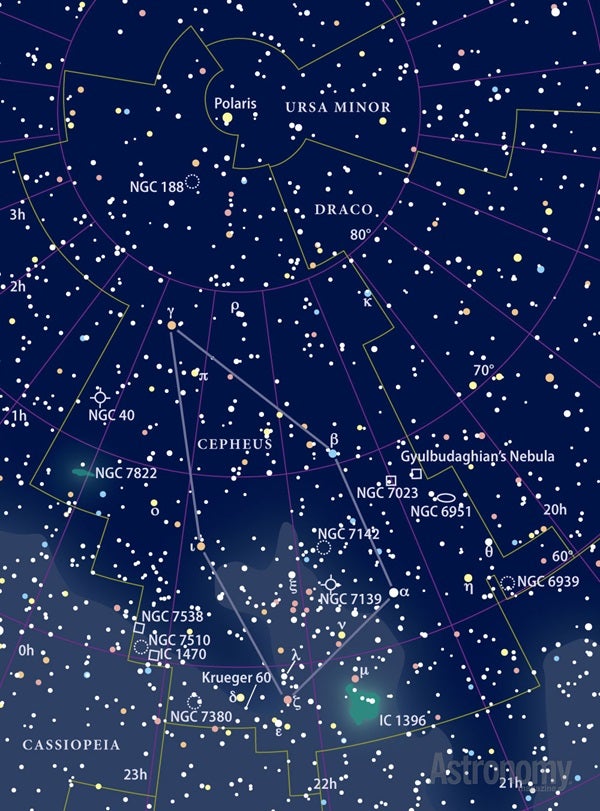Targets for September 18–25, 2014
Small telescope: Open cluster M29
Large telescope: Spiral galaxy NGC 6951
Large telescope: The Egg Nebula (PK 80–6.1)
This week’s small-telescope target is the Cooling Tower, also known as open cluster M29 in Cygnus. Although this star group is a Messier object, it’s one of the most difficult to identify. The reason is that M29 is a loose open cluster of about two dozen stars lying in front of a rich Milky Way star field.
To find M29, look 1.8° south of magnitude 2.2 Sadr (Gamma [γ] Cygni). It shines at magnitude 6.6 and measures 6′ across. A small telescope works best on this cluster because it won’t reveal the multitude of surrounding stars. To prove this to myself, I once made a cardboard insert for the front of a 12-inch telescope.
The insert had a 3-inch diameter hole drilled in it. I viewed M29 (and many other objects) with and without the insert, and the cluster was, indeed, easier to pick out when the insert was in place.
British amateur astronomer Jeff Bondono gave M29 its common name. He thought two curving lines of its stars looked like the concave sides of a cooling tower at a nuclear power plant.
A king’s spiral
This week’s first large-scope object is spiral galaxy NGC 6951 in Cepheus. This celestial treat lies 5.7° northwest of magnitude 2.5 Alderamin (Alpha [α] Cephei).
Although you can spot this magnitude 10.7 object through an 8-inch telescope, you’ll need at least a 12-inch scope to pick out any detail. It measures 3.7′ by 3.3′, so it’s not huge. At magnifications above 250x, try to spot the thin spiral arm toward the southeast. Look for the magnitude 12.2 star GSC 4258:1945 superposed on the galaxy’s western edge.
Catch this egg
This week’s second large-telescope target is the Egg Nebula, also known as PK 80–6.1 in the constellation Cygnus. The “PK” designation comes from a catalog of planetary nebulae compiled by Czech astronomers Luboš Perek and Luboš Kohoutek and published in Prague in 1967.
To be fair, the Egg Nebula is a much more interesting object scientifically than visually. That’s because its magnitude is 13.5 and it spans only 16″. But it’s such an amazing object scientifically that I thought you’d like to see it. Astronomers classify PK 80–6.1 as a bipolar protoplanetary nebula with highly polarized outflow.
Notwithstanding its faint glow and small size, with a bit of effort, you can spot the Egg Nebula through a 10-inch telescope if your sky is dark and steady. It lies 0.7° due east of magnitude 6.0 SAO 70794. Crank the power to 200, and look for a slightly elongated “star.” Through at least a 16-inch scope, insert and rotate a polarizing filter, and you’ll see the nebula dim quite a lot.
And, how, you ask, did this object get its common name? In May 1974, Mike Merrill of the University of California at San Diego observed this object with the 60-inch infrared telescope atop Mount Lemmon near Tucson, Arizona.
While examining photographic prints of the National Geographic Society Palomar Sky Survey, Merrill found that PK 80–6.1’s position coincided with that of a small egg-shaped nebulosity. He called the interstellar cloud the Egg Nebula.
Expand your observing at Astronomy.com
StarDome
Check out Astronomy.com’s interactive StarDome to see an accurate map of your sky. This tool will help you locate this week’s targets.
The Sky this Week
Get a daily digest of celestial events coming soon to a sky near you.
Observing Talk
After you listen to the podcast and try to find the objects, be sure to share your observing experience with us by leaving a comment at the blog or in the Reader Forums.











